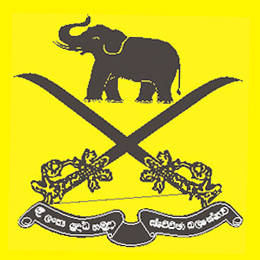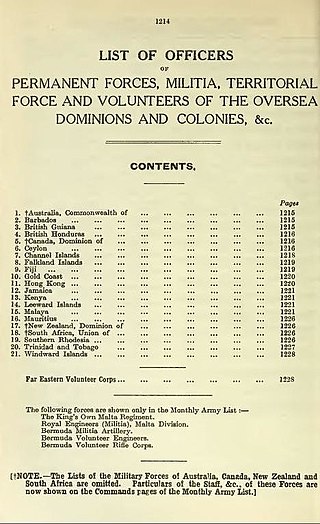| Sri Lanka Army |
|---|
 |
| Components |
| History |
| Equipment |
| Leadership and ranks |
This is a list of all combat and combat support regiments and corps of the Sri Lanka Army.
| Sri Lanka Army |
|---|
 |
| Components |
| History |
| Equipment |
| Leadership and ranks |
This is a list of all combat and combat support regiments and corps of the Sri Lanka Army.
The Ceylon Defence Force (CDF) was established in 1910 by the Ceylonese legislation Ceylon Defence Force Ordinance, which reformed the Ceylon Volunteer Force (CVF) that existed previously as the military reserve in the British Crown colony of Ceylon. At the time of forming it was only a reserve force but soon developed into a regular force responsible for the defence of Ceylon. The CDF was under the command of the General Officer Commanding, Ceylon of the British Army in Ceylon if mobilised. However mobilisation could be carried out only under orders from the Governor.
The hackle is a clipped plume or short spray of coloured feathers that is attached to a military headdress, with different colours being associated with particular regiments.

A rifleman is an infantry soldier armed with a rifled long gun. Although the rifleman role had its origin with 16th century hand cannoneers and 17th century musketeers, the term originated in the 18th century with the introduction of the rifled musket. By the mid-19th century, entire regiments of riflemen were formed and became the mainstay of all standard infantry, and rifleman became a generic term for any common infantryman.

The uniforms of the British Army currently exist in twelve categories ranging from ceremonial uniforms to combat dress. Uniforms in the British Army are specific to the regiment to which a soldier belongs. Full dress presents the most differentiation between units, and there are fewer regimental distinctions between ceremonial dress, service dress, barrack dress and combat dress, though a level of regimental distinction runs throughout.

A rifle regiment is a military unit consisting of a regiment of infantry troops armed with rifles and known as riflemen. While all infantry units in modern armies are typically armed with rifled weapons the term is still used to denote regiments that follow the distinct traditions that differentiated them from other infantry units.

The Sri Lanka Army is the oldest and largest of the Sri Lanka Armed Forces. Established as the Ceylon Army in 1949, it was renamed when Sri Lanka became a republic in 1972. In 2010, the Army had approximately 200,000 regular personnel, between 20,000 and 40,000 reserve (volunteer) personnel and 18,000 National Guardsmen and comprises 13 divisions, one air-mobile brigade, one commando brigade, one special forces brigade, one independent armored brigade, three mechanized infantry brigades and over 40 infantry brigades.

For the purposes of parading, the regular army & the volunteer force of the Sri Lanka Army is listed according to an order of precedence.
The Sri Lanka Engineers (SLE) is a combat support arm of the Sri Lanka Army which provides military engineering. It is made up of ten regular regiments and one volunteer regiment. Headquartered at Panagoda Cantonment, it is headed by the Centre Commandant.

The Sri Lanka Signals Corps (SLSC) is a combat support corps of the Sri Lanka Army, responsible for providing military communications, information technology and electronic warfare support. The corps is made up of a signals brigade, ten regular regiments and one volunteer regiment. It is responsible for installing, maintaining and operating all types of telecommunications equipment and information systems. It is headquartered at the Panagoda Cantonment.

The Sri Lanka Army Volunteer Force (SLAVF) is the active-duty volunteer reserve force of the Sri Lanka Army. The SLAVF is separate from the Regular Force which consists of personal who are professional soldiers and its Regular Reserve, which comprises personal who have a mobilization obligation following their service in the regular army. The SLAVF consists of the volunteer force and the volunteer reserve; administration and recruitment of reserve personal is carried out by the Volunteer Force Headquarters in Shalawa, Kosgama which is headed by the Commandant of the Volunteer Force. It has a current strength of about 55,000 personnel. The SLAVF was known as the Ceylon Volunteer Force from 1949 to 1972 and the Sri Lanka Volunteer Force from 1972 to 1985.
The Ceylon Planters Rifle Corps was a regiment of the Ceylon Defence Force, which existed between 1900 and 1949. It was a volunteer (reserve) regiment based in Kandy, made up of only Europeans that were tea and rubber planters of the hills of Sri Lanka. The regiment deployed personnel to fight in the Second Boer War, the First, and Second World Wars.
Ceylon Mounted Rifles was the only cavalry regiment attached to the Ceylon Defence Force which was the predecessor to the Sri Lanka Army prior to 1949 when the Ceylon Army was formed. It was a volunteer (reserve) regiment was based in Colombo made up of only of British.
Panagoda Cantonment is a cantonment located in the western Western Province of Sri Lanka. It serves as the regimental headquarters of many regiments of the Sri Lanka Army and is an arsenal. It also houses one of the main Military Hospitals operated by the Sri Lanka Army Medical Corps. It is one of the largest military bases in Sri Lanka.

The British Colonial Auxiliary Forces referred to the various military units of Britain's colonial empire which were not considered part of the British military proper. Though the first colonial units established in the British Empire were militia formations in Britain's American colonies, by the Victorian era these units were modelled after the regular armed forces of Britain and consisted of professional soldiers. They supplied a reserve force either to be called up in war time to reinforce regular British Army garrisons for home defence, or in some cases were entirely responsible for home defence. Many units, however, took part in active campaigns outside of the role of home defence in various conflicts the British Empire was involved in, including the two world wars.

Troops began wearing berets as a part of the headgear of military uniforms in some European countries during the 19th century; since the mid-20th century, they have become a component of the uniforms of many armed forces throughout the world. Military berets are usually pushed to the right to free the shoulder that bears the rifle on most soldiers, but the armies of some countries, mostly within Europe, South America, and Asia, have influenced the push to the left.
In September 1939, the British Army was in process of expanding their anti-aircraft and mobile assets. Among these new changes was the formation of Anti-Aircraft Command which was formed on 1 April 1939, and the 1st Armoured Division formed in 1937. The list below will include the British Army units, colonial units, and those units which were in the process of formation.

General L. D. E. Cecil Waidyaratne, VSV, USP was a Sri Lanka Army officer. He was 12th Commander of the Sri Lankan Army and a former Sri Lankan Ambassador to Thailand.

The uniforms of the Sri Lanka Army currently exist in several categories ranging from ceremonial uniforms to combat dress.

Sri Lankan military bands refer to the joint-service musical units of the Sri Lanka Armed Forces representing the Sri Lanka Army, the Sri Lanka Navy, and the Sri Lanka Air Force. The three bands mentioned, which were established in 1949, 1952 and 1970 respectively and are the seniormost in the armed forces. They are composed of many ceremonial marching bands as well as concert bands which are base for the band's success. The band participates in main social and cultural events, including formal state visits and military parades. All army regiments also contain a regimental band for ceremonial duties.
Future Soldier is a reform of the British Army resulting from the Integrated Review of Security, Defence, Development and Foreign Policy published in March 2021. The aim of the reform is to create a more lethal, agile and expeditionary force, able to fight and win wars and to operate in the grey-zone between peace and war. Future Soldier was published on 25 November 2021 and deals with the organizational changes of the British Army, with changes to personnel and equipment were set out in the Defence in a Competitive Age paper published on 22 March 2021.